Sometimes I lie to Ali.
I say things like, “I’ve got a game for us to play today!!”
When the truth is that I’m banging my brain against the inside of my skull trying to hurry up and concoct an idea to make school into a game while she asks repeatedly, “What?? What is the game??”
Sometimes I get lucky and she totally buys it, and other times I don’t and she says “That wasn’t a game. That was just schoolwork.”
This lying pattern is most prevalent in my life on the mornings when it is apparent that she’s not excited about school. And yes – I know that one day, she’s going to have to learn that it doesn’t matter whether she’s excited or not.
But for now, I want her to at least think that learning is fun. So I’d prefer to lie to her and hope I can come up with something before she loses faith.
Which is what brings us to today: one of my rare wildly successful game attempts.
I made an Excel template for her multiplication tables to save myself the manual drawing of it. On a whim, I highlighted some of the squares pink before I printed it out. And it looked like a game.
“Mommy!! Where are you?? I thought we were starting school!”
“We are! I’m just…I’m just getting a game for us to play!”
“What game?? What’s the game??”
thirty minutes later…
“I WON!!! I WON!!! THAT WAS AN AWESOME GAME!!!! Can you call Gramamma and tell her that I beat you? Can you tell everyone on your blog that I beat you???”
So I am here to tell you: She beat me fair and square, and practiced multiplication while she was doing so.
Here’s how to play:
All you need is a game board template (feel free to download mine, modify mine, or make your own), two pencils, and either a dice, number cards, or a number spinner.
(We used 1-10 number cards from another board game.)
Print out the game board and put the first answer in the middle. We were playing multiplication, so 5 x 5 = 25. You can totally play as addition, though, in which case 5 + 5 = 10.
Player One rolls the dice, draws a number card, or spins the wheel. Let’s say they get a three. They can choose to solve any problem that is three spaces away from the starting square:
The answer to the square they choose is their point value for that round, and the pink squares are worth double.
(For the pink squares, they still write the answer to the actual problem, but when figuring the score, double it.)
Player two then rolls, draws, or spins. Let’s assume they get a five. They can pick a problem five squares away from the last play. In this case, they have less options available to them:
If a player rolls, draws, or spins a number that is impossible to play (such as a ten, in the case above,) they don’t get to play that turn. This will come up more as the game goes on and more squares are already solved.
Play until the board is filled, or until you’ve played a set number of turns. We played until I could sense that Ali’s interest was about to downgrade.
While thinking we were totally just playing a game, Ali practiced multiplication in a way that made her think differently,
practiced writing numbers,
and practiced her victory gloating.
Here are the benefits I see to this game:
- It puts the kid in charge: will they choose an easier square and make less points, or a harder square to make more points?
(It may also give you insight into their level of competitiveness.) - It breaks up the monotony of filling out a multiplication table, therefore making sure that the process isn’t rote.
- The gameplay takes skill, but winning partially depends on the luck of the draw, therefore leveling the playing field between parent and child or between different aged children. I drew too high of a number to play several times, and Ali lucked into some good very draws.
Ways to adjust for other learning levels:
- Easier: Use it for addition rather than multiplication.
- Easier: Use a smaller board – for instance, only go up to 5.
- Harder: Make the kid figure out what the double score would be.
- Harder: Modify the playing board to contain multiple colors of squares for doubling, tripling, and quadrupling the points.
- Harder: Have the kid add up the final scores.
- Variety: Change the location of the squares.
Enjoy, and be sure to let me know if you get beat by a kid!

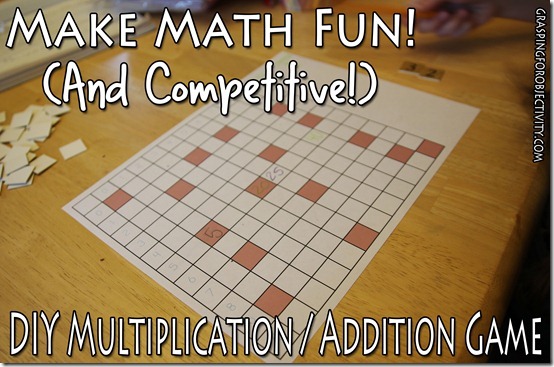
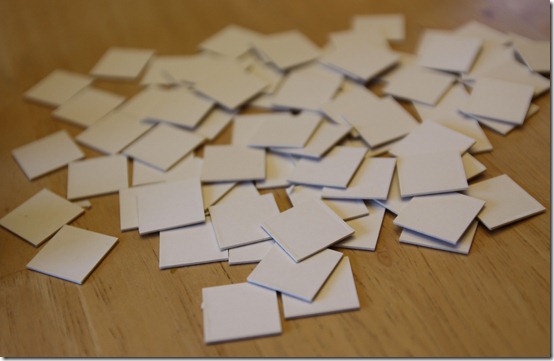
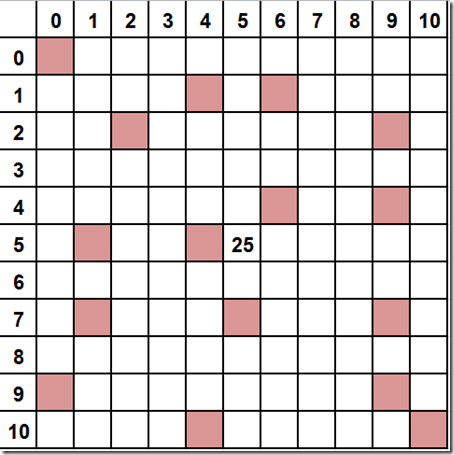
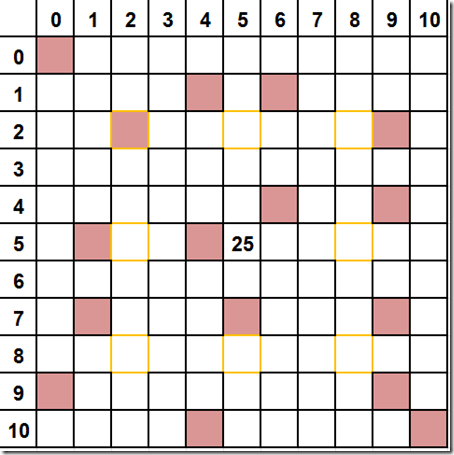
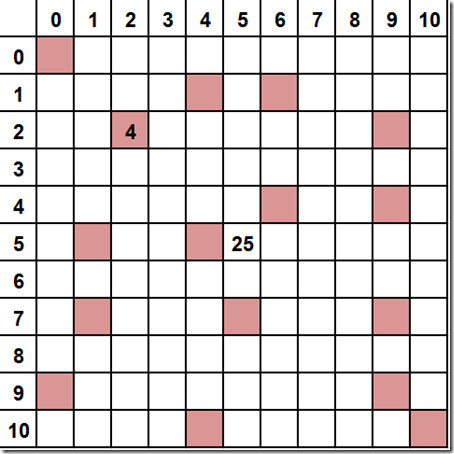
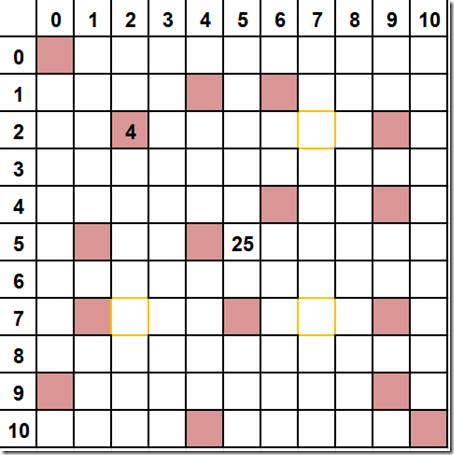
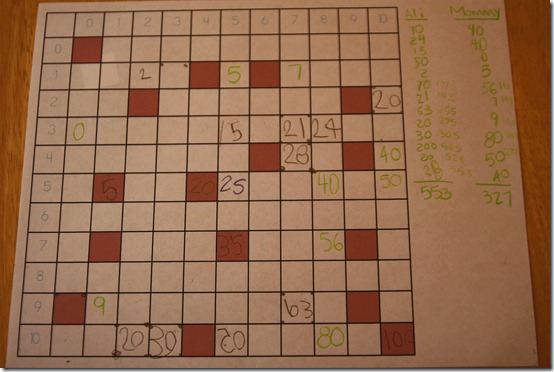
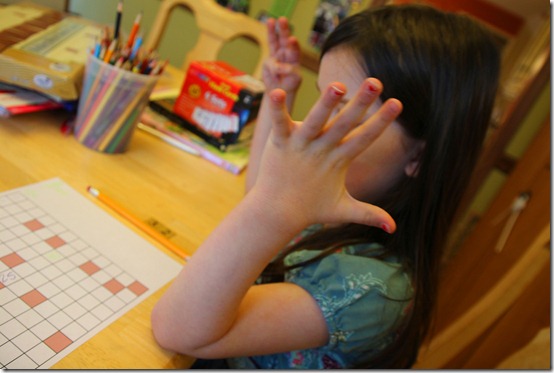
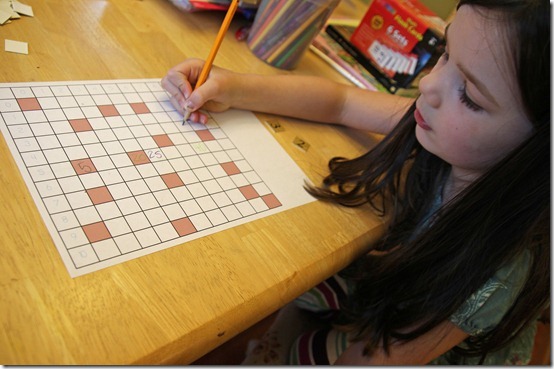

Former elementary school teacher here: Good job, Mom!
This looks like fun! I think my two older ones would really enjoy it. Good job!
Love it! I also saw on Pinterest a way to play Chutes & Ladders with math. My daughter loves it! I think we’ll be trying this
P.S. I also do sight word bingo with my younger daughter. She loves it and asks to play!
There’s a great iphone/ipad sight word bingo game, as well as math bingo. If you ever need them to play by themselves and let you get something done for a moment!!
I love the multiplication or addition game that I saw on pinterest – where they roll the dice and then solve any problem that is that number away from the starting square.
Just one question – when players take their next turns, do they always have to pick a problem the number of spaces away from the last play or can they choose to play from any square which has a number.
Thanks
The way I wrote it was to move from the last square played. Glad you like it!
I have been lurking for a while now and missed “De-Lurking Day” so Hello! I loved this post so I had to come out and say:
What a great idea!!!!
I’ve got to ask, did her competitive spirit lead her to avoid the 0s on purpose? What a clever little girl! I love how you set this up to encourage her not only to answer the problems but to really think about WHICH problem would give her the most advantage, it really sounds like it would help solidify her understanding of multiplication and how it all works. Although, what a tease to have one of the pink squares on 0x0 lol!
This is seriously a super fun idea and I am going to use it with my girls!
Hi Jen! Thanks for saying hi!
Yes – she almost chose a pink 0 square because it would be doubled, until I asked her what double 0 was – then she definitely went the other way!
Oh, that looks like fun. I’m going to have to try that with S, using addition.
This game is great! I only wish I’d had it in my arsenal when I was a teacher. Oh well, I can use it with my son in a few years time.
I might have a little OCD your 7X7 square is only 4 spaces away from your 5X5 square in your example. :-)
Might help if I read the directions right. :-)
Cool! It’s like scrabble. You could probably base other versions off other games. For instance, a game where you move along a path, but by multiplying the numbers on 2 dice together. You could land on squares where you have to go back by half. Or move forward by 3×5, etc.
Yes – there are endless combinations! I’m excited to try different ones.
Fun! I’ll have to try this. We have only done a little multiplication though. Still trying to solidify addition/subtraction. I might try this with subtraction since K doesn’t like it as much.
The only problem is that you’ll have to make the rule that you’re always subtracting the smaller number from the larger one, so you don’t run into negative numbers – unless y’all are already ready for that!
Love it! We’ll be playing after our field trip tmrw. Thx, Rach!
This is a great idea! I think we’ll do a version of this when we start addition (any day now).
And, can I just say that I love that your 6 year-old is doing multiplication. I love that homeschooling allows us to help them zoom ahead when they are passionate.
Yup, although we’ve gone back this semester and started working more on memorizing addition facts. It’s fun to get ahead, but I also have to not forget to make sure she *really* knows the easier facts – thorough is hard for me!
playing today for FUN FRIDAY! M will do prime factoring with it and C adding doubles so I will have to figure out a different scoring method. But, I think it will work.
Excellent! Did it work? I hope so!
Thanks for the idea. Played this last night using the addition game and it took us 1.5 hours. ;). My son was engaged the whole time. Thanks. I really appreciate you sharing your ideas. I try to work with my kids at home, but as my oldest tells me frequently, “You’re not my teacher, you’re my mom.” (I am a former teacher! LOL!)
That’s fabulous!! I’m impressed that he was focused that long. Great job!
This is soooo cool! I’m storing this away for my possible homeschooling ventures in the future, and I’m going to see if I can adapt it to be a center in library so I can use it right now with my students. You are so clever!
My son and I just finished playing this game, and it was so fun! Thank you! He was very enthusiastic about playing again sometime.,
That’s great! I’m glad it went well for you guys.
you are too creative and smart! you must have been homeschooled. my goodness girl. and ali is already doing multiplication! wow.
Just found this via Pinterest and I know my son is going to love it! Even if he knows we are “doing school” he doesn’t care as long as it resembles a game.
Thank you so much for this game. I had our upper grades do it for multiplication and our lower grades do it with addition and they had so much fun they didn’t want to stop the game. It worked on so many different things I loved it!
That’s fantastic! I’m glad it was a hit.
I am SO glad I found your site again! I used this math game over the summer and couldn’t remember where I got it from. I’ve been looking for your post so I could give you a BIG THANK YOU! I’m a private tutor and I have used this game with K-5th grade students… and they ALL love it! Thanks for the wonderful activity!
Thanks for this game. It’s great. I”m going to use it with my class this week. I’m sure they will love it.
I love the idea. I’m just having trouble printing the board. What size paper did you print this on?
I just found your blog via Pinterest. I teach a 3/4 combined classroom. I’m always looking for new “games” to help my students learn. I am planning to print and use this during the year to reinforce our multiplication tables. Thank you!
I just found this on Pinterest too. I think it will work great with my Grade 6 class if I introduce it as a strategy game. Player A can choose a low score to leave Player B only middle scoring options but forcing them to leave Player A a chance to go for the really high scores. I think they will also see that doubling is often not the best score, so I may say the game ends when one player has 6 pink squares. More strategy because they don’t want to end it when they are behind. Thanks for the inspiring idea!
Great game. Thanks for the free download. This will be perfect to play on the plane with my 3rd grader on our upcoming trip to Spain!
Looks great – always looking for different activities and ways for teachers and parents to use to encourage and engage children in learning tables – which could be a rather mundane and boring activity – thanks for the game and the variety of ways of modifying the game. I am sure that once introduced to parents teachers and children they will find other rules and ways of using the boards.